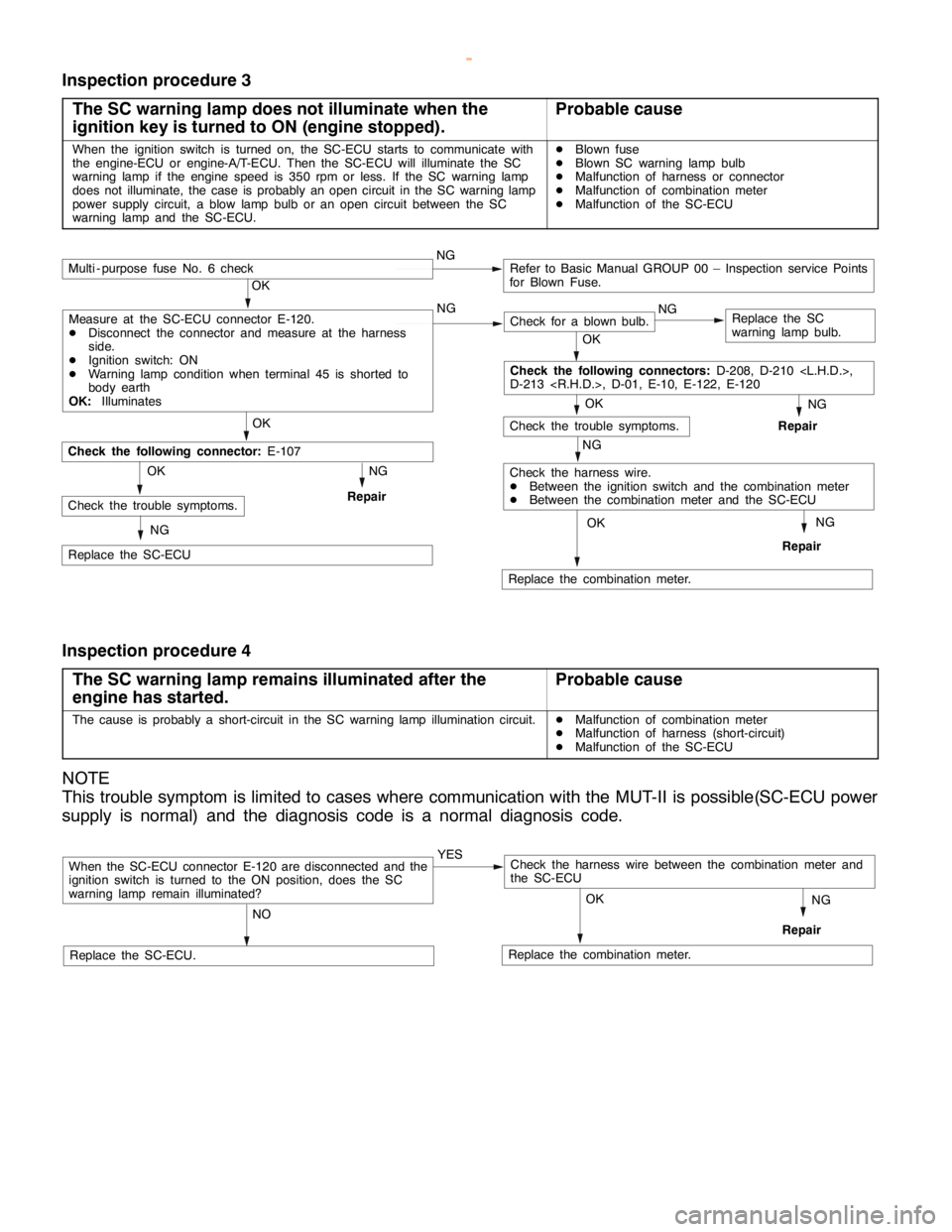2000 MITSUBISHI MONTERO ECU
[x] Cancel search: ECUPage 602 of 1839

MITSUBISHI SC-Troubleshooting13E-13
Inspection procedure 2
Communication with MUT-
IIand the SC-ECU is not
possible.
Probable cause
The cause is probably an open circuit in the SC-ECU power supply circuit or an
open circuit in the diagnosis output circuit.DMalfunction of harness or connector
DMalfunction of the SC-ECU
NG
Repair
OK
Check the trouble symptoms.
NG
Check the harness wire between SC-ECU and diagnosis
connector, and repair if necessary.
OK
Measure at SC-ECU connector E-121 and diagnosis connector
D-23.
DDisconnect the connectors and measure at the harness
side.
DContinuity between the following terminals:
Between terminals 1 (SC-ECU side) and 1 (diagnosis
connector side)
Between terminals 14 (SC-ECU side) and 7 (diagnosis
connector side)
Between terminals 23 (SC-ECU side) and 14 (diagnosis
connector side)
OK:
ContinuityNGCheck the following connectors:
E-121, E-122, D-128, E-13,
D-33, D-222, D-23
OK
NG
Repair
OK
Check the trouble symptoms.
NG
OKNG
Repair
OK
(1)NGCheck the following connectors:
B-25X, D-128, E-122,
E-121
NG
Check the harness wire between the engine control relay and
the SC-ECU, and repair if necessary. (2)NG
OK
Check the trouble symptoms.
NG
Replace
NG
Check the harness wire between the battery and the SC-ECU,
and repair if necessary.
Check the following connectors:
D-27, D-223
D-31
Measure at SC-ECU connectors E-120, E-121.
DDisconnect the connector and measure at the harness
side.
(1) Voltage between terminal 25 and body earth
(Ignition switch: ON)
OK:
System voltage
(2) Voltage between terminal 39 and body earth
OK:
System voltage
NG (1)NG
Check the harness wire between the SC-ECU and the body
earth, and repair if necessary.
Repair
NG
Replace the SC-ECU.
Check the trouble symptoms.
Check the following connectors:
E-120, E-122
NG
(2), (3)NG
Check the harness wire between the SC-ECU and the body
earth, and repair if necessary.
OK
NG
Repair
NGCheck the trouble symptoms.
Check the following connector:
E-121, E-122
OK
Check the trouble symptoms.
Measure at SC-ECU connector E-120, E-121.
DDisconnect the connector and measure at the harness
side.
(1) Continuity between 31 and body earth
OK:
Continuity
(2) Continuity between 13 and body earth
OK:
Continuity
(3) Continuity between 26 and body earth
OK:
Continuity
Check the trouble symptoms.
Check the fusible link No.2 and dedicated fuse No.7
www.WorkshopManuals.co.uk
Purchased from www.WorkshopManuals.co.uk
Page 603 of 1839

MITSUBISHI SC-Troubleshooting13E-14
Inspection procedure 3
The SC warning lamp does not illuminate when the
ignition key is turned to ON (engine stopped).
Probable cause
When the ignition switch is turned on, the SC-ECU starts to communicate with
the engine-ECU or engine-A/T-ECU. Then the SC-ECU will illuminate the SC
warning lamp if the engine speed is 350 rpm or less. If the SC warning lamp
does not illuminate, the case is probably an open circuit in the SC warning lamp
power supply circuit, a blow lamp bulb or an open circuit between the SC
warning lamp and the SC-ECU.DBlown fuse
DBlown SC warning lamp bulb
DMalfunction of harness or connector
DMalfunction of combination meter
DMalfunction of the SC-ECU
NG
Replace the combination meter.
NG
Repair
OK
NG
Check for a blown bulb.Replace the SC
warning lamp bulb.
OK
NG
Repair
OK
Check the trouble symptoms.
Multi - purpose fuse No. 6 checkNGRefer to Basic Manual GROUP 00 – Inspection service Points
for Blown Fuse.
NG
Check the harness wire.
DBetween the ignition switch and the combination meter
DBetween the combination meter and the SC-ECU
OK
OK
Replace the SC-ECU
Check the following connector:
E-107
NG
RepairCheck the trouble symptoms.OK
NG
Check the following connectors:
D-208, D-210
D-213
Measure at the SC-ECU connector E-120.
DDisconnect the connector and measure at the harness
side.
DIgnition switch: ON
DWarning lamp condition when terminal 45 is shorted to
body earth
OK:
Illuminates
Inspection procedure 4
The SC warning lamp remains illuminated after the
engine has started.
Probable cause
The cause is probably a short-circuit in the SC warning lamp illumination circuit.DMalfunction of combination meter
DMalfunction of harness (short-circuit)
DMalfunction of the SC-ECU
NOTE
This trouble symptom is limited to cases where communication with the MUT-II is possible(SC-ECU power
supply is normal) and the diagnosis code is a normal diagnosis code.
When the SC-ECU connector E-120 are disconnected and the
ignition switch is turned to the ON position, does the SC
warning lamp remain illuminated?YES
NO
Replace the SC-ECU.Replace the combination meter.
NG
Repair
OK
Check the harness wire between the combination meter and
the SC-ECU
www.WorkshopManuals.co.uk
Purchased from www.WorkshopManuals.co.uk
Page 604 of 1839

MITSUBISHI SC-Troubleshooting13E-15
DATA LIST REFERENCE TABLE
The following ECU input data items can be read using the MUT-
II.
Item
No.Check itemInspection conditionsNormal condition
10Vehicle speedWhen vehicle is being drivenSpeedometer display and
MUT-IIdisplay are identical.
11AcceleratorIgnition switch:Release the accelerator pedal.0.9 - 1.1 V
pedal position
sensorONDepress the accelerator pedal gradually.Increases in response to
pedal depression stroke.
Depress the accelerator pedal fully4.0 V or more
18Power supply
voltageIgnition switch: ONSystem voltage
19Accelerator
pedal positionIgnition switch:
ONRelease the accelerator pedalON
pedal position
switch (Idle
switch)ON
Depress the accelerator pedal slightly.OFF
20Ignition switchIgnition switch: ONON
Ignition switch: OFFOFF
22Front-right
wheel speedWhen vehicle is being drivenSpeedometer display and
MUT-IIdisplay are identical.
28Engine typeVehicles with the 6G74 engine6G74
Vehicles with the 4M41 engine4M41
30Trace controlSC system control is activeON
SC system control is not activeOFF
31Engine specifi-Vehicles with the 6G74 engineDOHC
cation 1Vehicles with the 4M41 engine-
32Engine specifi-Vehicles with the 6G74 engineN/A
cation 2Vehicles with the 4M41 engine-
33Engine specifi-Vehicles with the 6G74 engineMIVEC/ETV
cation 3Vehicles with the 4M41 engine-
35Destination-EC
40Engine speedDepress the accelerator pedal gradually.Tachometer display and
MUT-IIdisplay are identical.
51Inhibitor switchIgnition switch:Selector lever position: PP
ONSelector lever position: RREngine:
stopped
Selector lever position: NN
Selector lever position: DD
52Shift positionSelector lever
position: sportsDriving at a constant speed of 10 km/h in
1st1st
modeDriving at a constant speed of 30 km/h in
2nd2nd
Driving at a constant speed of 50 km/h in
3rd3rd
Driving at a constant speed of 50 km/h in
4th4th
Driving at a constant speed of 70 km/h in
5th5th
www.WorkshopManuals.co.uk
Purchased from www.WorkshopManuals.co.uk
Page 607 of 1839

MITSUBISHI SC-Troubleshooting/On-vehicle Service13E-18
Terminal No.Signal nameNormal condition
Between terminal 13 and body earthEarthContinuity
Between terminal 26 and body earthEarth
Between terminal 31 and body earthEarth
ON-VEHICLE SERVICE
OPERATION TEST OF MITSUBISHI SC
1. Connect the MUT-
IIto the 16-pin diagnosis connector.
Caution
Turn the ignition switch to the LOCK (OFF) position
when connecting and disconnecting the MUT-
II.
2. Move the shift lever to the neutral
lever to the P range.
3. Start the engine.
4. Use the MUT-
IIto activate the Actuator Test (item No.05)
while depressing the accelerator pedal fully. Check that
the engine speed should decrease gradually.
Caution
Activate the Actuator Test for three seconds.
Release the accelerator pedal immediately after the
Actuator Test is complete, or the engine speed will
rise.
NOTE
During the Actuator Test, the SC-ECU transmits the signal,
which requests no torque and wide open throttle, to the
engine-ECU or engine-A/T-ECU for three seconds.
WHEEL SPEED SENSOR (FR) CHECK
Refer to Basic Manual GROUP 35B - On-vehicle service.
VEHICLE SPEED SENSOR CHECK
Refer to Basic Manual GROUP 54A - Combination Meter.
www.WorkshopManuals.co.uk
Purchased from www.WorkshopManuals.co.uk
Page 611 of 1839

13E-1
DIESEL FUEL
<4D5-STEPIII
>
CONTENTS
GENERAL 2.................................
Outline of Change 2............................
GENERAL INFORMATION 2...................
SERVICE SPECIFICATIONS 4.................
SEALANT 4..................................
SPECIAL TOOLS 5...........................
TROUBLESHOOTING 6.......................
ON-VEHICLE SERVICE 55....................
Injection Nozzle Check and Adjustment 55.........
Injection Timing Check and Adjustment 55.........
Idle Speed Check and Adjustment 55.............
Accelerator Pedal Position Sensor (APS)
Adjustment 56.................................
Control Relay Continuity Check 57................
Accelerator Pedal Position Sensor (APS)
Check 57......................................Idle Switch Check 58............................
Boost Air Temperature Sensor (Intake Air
Temperature Sensor) Check 58..................
Engine Coolant Temperature Sensor Check 59.....
Evacuation of Water from Fuel Filter 59............
Fuel Filter Cartridge Replacement 60..............
Evacuation of Air from Fuel Line 60...............
EGR Valve Position Sensor Check 60.............
Fuel Injection Pump Check 61....................
Throttle Solenoid Valve Check 62.................
Throttle Actuator Check 63......................
Variable Geometry Solenoid Valve Check 63.......
EGR Control Solenoid Valve Check 63............
FUEL INJECTION NOZZLE 64.................
FUEL INJECTION PUMP 64...................
CRANKSHAFT POSITION SENSOR 66.........
ENGINE-ECU 66.............................
www.WorkshopManuals.co.uk
Purchased from www.WorkshopManuals.co.uk
Page 612 of 1839

DIESEL FUEL <4D5-stepIII>-General/General Information13E-2
GENERAL
OUTLINE OF CHANGE
An electronically-controlled injection pump has been added in order to comply with Regulation STEP
III. Due to this, the following service procedures have been added.
GENERAL INFORMATION
The electronically-controlled fuel injection system consists of sensors which detect the condition of the
diesel engine, an engine-ECU which controls the system based on signals from these sensors, and actuators
which operate according to control commands from the engine-ECU.
The engine-ECU carries out operations such as fuel injection rate control, fuel injection timing control
and idle up control. In addition, the engine-ECU is equipped with several self-diagnosis functions which
make troubleshooting easier in the event that a problem develops.
FUEL INJECTION RATE CONTROL
The fuel injection completion timing is controlled by means of a solenoid-type spill valve to ensure that
the optimum amount of fuel is supplied to the engine in accordance with gradual changes in the engine
running condition.
Before fuel injection starts, the solenoid-type spill valve is on (energized), so that the valve is closed.
As the plunger turns and rises, fuel is sent out under pressure, and when the fuel flow rate reaches
the target value for fuel injection, the solenoid-type spill valve turns off. When the solenoid-type spill
valve turns off, the fuel under high pressure inside the plunger is leaked out into the pump chamber
and fuel injection is completed.
FUEL INJECTION TIMING CONTROL
The position of the injection pump timer piston is controlled so that fuel injection is carried out at the
optimum timing in accordance with the engine running condition.
The timer piston position is determined by duty control of the timing control solenoid valve which is located
in the line between the high-pressure chamber and the low-pressure chamber of the timer piston.
The fuel injection timing is advanced by increasing the control duty of the timing control solenoid valve.
IDLE SPEED CONTROL
Controlling the fuel injection rate in accordance with the engine running condition maintains the idle speed
at the optimum condition.
SELF-DIAGNOSIS FUNCTION
DWhen an abnormality is detected in any of the sensors or actuators, the engine warning lamp illuminates
to warn the driver.
DWhen an abnormality is detected in any of the sensors or actuators, a diagnosis code number
corresponding to the problem which occurred is output.
DThe RAM data relating to the sensors and actuators which is stored in the engine-ECU can be read
using the MUT-II. In addition, the actuators can be force-driven under certain conditions.
OTHER CONTROL FUNCTIONS
1. Power Supply Control
When the ignition switch is turned to ON, the relay turns on and power is supplied to components
such as the timing control solenoid valve.
2. Intake Air Throttle Control
When the engine-ECU detects an abnormality in any of the sensors or actuators, the throttle valve
is half opened to restrict the amount of intake air in order to prevent the vehicle from running away.
3. A/C Relay Control
Turns the compressor clutch of the A/C ON and OFF
4. Condenser Fan Motor Relay Control
Controls the condenser fan motor relay based on the A/C switch, engine coolant temperature and
vehicle speed input signals.
5. Glow Control
Refer to GROUP 16.
6. EGR Control
Refer to GROUP 17.
www.WorkshopManuals.co.uk
Purchased from www.WorkshopManuals.co.uk
Page 617 of 1839

DIESEL FUEL <4D5-stepIII>-Troubleshooting13E-7
FAIL-SAFE, BACKUP FUNCTIONS
When abnormalities in the major sensors are detected by diagnosis functions, pre-set control logic operates
to maintain a safe driving condition for the vehicle.
Diagnosis itemControl features in malfunction
Accelerator pedal position sensorDAccelerator pedal released (idle switch ON)
Acceleration opening degree = 0 %
DAccelerator pedal applied (idle switch OFF)
Engine controlled at low speed
Acceleration opening degree = 30 % fixed
DVoid EGR control
Idle switchVoid idling speed control.
Engine speed sensorDEngine controlled at low speed
DVoid EGR control
DVoid variable geometry turbocharger control
Boost air temperature sensorDMaintain the intake air temperature at 50_C.
DVoid EGR control
Vehicle speed sensorDVoid idling speed control.
DVoid EGR control
Engine coolant temperature sensorDMaintain the engine coolant temperature at 80_C (However, the system
assumes the coolant temperature as 0_C).
DVoid EGR control
Control sleeve position sensorDEngine controlled at low speed
DVoid EGR control
DVoid variable geometry turbocharger control
Timer piston position sensorDInjection timing stabilizing control
DVoid EGR control
Barometric pressure sensor (ECU
built-in)DKeep the barometric pressure at 101 kPa.
DVoid EGR control
DVoid variable geometry turbocharger control
Fuel temperature sensorMaintain the fuel temperature at 40_C.
Boost pressure sensorDKeep the boost pressure as barometric pressure (101 kPa).
DVoid EGR control
DVoid variable geometry turbocharger control
Injection volume adjusting ROMVoid correction.
GE actuatorDEngine controlled at low speed
DVoid EGR control
DVoid variable geometry turbocharger control
Over boostDVoid variable geometry turbocharger control
DEngine controlled at low fuel injection
Timing control valveDInjection timing stabilizing control
DVoid EGR control
EGR valve position sensorVoid EGR control
Variable geometry control pressure
sensorDVoid EGR control
DVoid variable geometry turbocharger control
www.WorkshopManuals.co.uk
Purchased from www.WorkshopManuals.co.uk
Page 618 of 1839

DIESEL FUEL <4D5-stepIII>-Troubleshooting13E-8
INSPECTION CHART FOR DIAGNOSIS CODES
Code No.Diagnosis itemReference
page
11Accelerator pedal position sensor (main) system13E-9
12*Boost pressure sensor system13E-10
13Barometric pressure sensor (ECU built-in) system13E-11
14Fuel temperature sensor system13E-11
15Engine coolant temperature sensor system13E-12
16Boost air temperature sensor system13E-12
17Vehicle speed sensor system13E-13
18Pump speed sensor system13E-14
21Crank angle sensor system13E-15
23Idle switch (accelerator pedal position sensor built-in) system13E-16
25*Timer piston position sensor system13E-17
26*Control sleeve position sensor system13E-18
27Accelerator pedal position sensor (sub) system13E-19
41*Throttle solenoid valve system13E-20
43Timing control valve system13E-21
46Injection volume adjusting ROM system13E-22
48*GE actuator (in the middle of control sleeve position sensor inoperative) system13E-23
49*Over boost (variable geometry control pressure sensor system malfunction)13E-24
51EGR valve position sensor system13E-25
52Variable geometry control pressure sensor system13E-26
54Immobilizer system13E-27
Caution
If the above-mentioned diagnosis code number with the asterisks can be displayed along with another
code number in parentheses simultaneously, check the other code number before replacing the
engine-ECU.
12 (41, 49), 26 (48), 25 (43), 41 (12, 49), 48 (26), 49 (12, 41)
www.WorkshopManuals.co.uk
Purchased from www.WorkshopManuals.co.uk